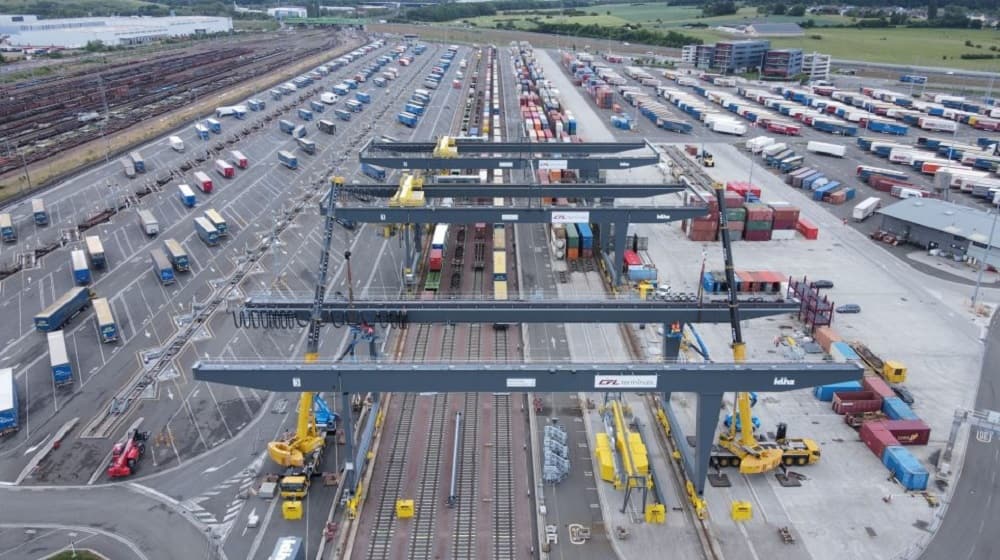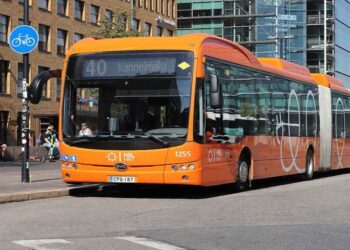The commissioning of a new semi-automated and remote-controlled crane for CFL multimodal’s terminal in Bettembourg-Dudelange in September 2022 is about to significantly increase the site’s handling capacity while providing more quality and safety in operations through innovative technologies. For Kuenz, the mastermind behind the new crane and CFL multimodal’s long-standing partner, the new crane is not only about security and trust but also about responsibility towards society and the environment.
Not much introduction is needed for the two partners; CFL multimodal is a major intermodal player in consolidating multimodal transport flows across Europe and beyond, while its terminal in Bettembourg-Dudelange is probably one of the most integrated facilities in Europe, with the latest technologies installed. It has four 700-meters-long tracks allowing it to handle multiple daily trains and, up until the new crane’s arrival, approximately 150.000 intermodal transport units (ITUs) a year.
As for Kuenz, the Austria-based innovative engineering company is well-known for developing cranes functioning with remote operation systems offering zero-emission operations. The Remote Operation Stations (ROS) that Kuenz deploys are key for the new and existing cranes that CFL multimodal’s terminal operates and its technological head start compared to other sites.
Deep intermodal knowledge
It is not the first time the two companies have worked together. Kuenz’s new semi-automated crane is the third one commissioned in Bettembourg. The first two were commissioned in 2015 and work with the same principles. As CFL multimodal explained, choosing Kuenz as a partner was a matter of employee and cargo safety, high reliability and performance, which is why they have been together since day one.
Daniel Feyder, Director CFL terminals, says: “We offer a variety of intermodal logistics solutions for the transhipment of goods that help the environmentally friendly rail transport develop its potential throughout Europe. The investment into the latest Kuenz technologies for gantry cranes, a future capacity of 235,000 ITUs, and the operation of two rail motorway platforms for handling 300,000 ITUs per year enables us to respond to the increased market demand for sustainable transport solutions”.
“At the same time, we will provide our customers more reliability, resilience and visibility along their supply chains by opening up new alternatives to already congested roads. Our Intermodal Terminal has reached the threshold of almost 1 million handlings to date, and since its inception in 2017, enabling the cross-border transport to 7 countries and thus saving around 110,000 tons of CO2 annually,” he adds.
On the other hand, Kuenz is a major intermodal player in crane and automation technologies. Vincent Pelletier, area sales manager at Kuenz, explains that the company has “implemented automation in the intermodal world and has the most references in the industry. Many cranes around the world have been running very successfully for many years in intermodal terminals in Europe and the US, with quality performance resulting in orders for more than 20 remote-operated intermodal RMG cranes for higher safety, productivity and flexibility”.
Regarding Luxembourg, Raphael Rüf, project manager at Kuenz, underlined that the company is “a proud part of Luxembourg’s infrastructure network and thus holds a key position in the expansion of the intermodal network in Europe.”
Up to 235,000 ITUs per year
The fact that Bettembourg is one of the most complete terminals in Europe with immense growth owes much to the two Kuenz RMG cranes being there since 2015. However, the recently commissioned third RMG crane will make an even more significant difference. Before diving into that, it is essential to highlight some of its features.
The new crane is semi-automated and can be operated from a Remote Operating Station (ROS). Remote operations improve the terminal’s productivity at lower costs while improving safety via a dedicated concept and an efficient camera system. On top of that, they make the crane operator’s job more attractive and help tackle the shortage of skilled workers.
Moreover, Kuenz’s new RMG crane will feature a non-spanned double girder, a rail span of 41,67 meters, and two single cantilevers of 13 meters each that will be equipped with a piggyback spreader. A TOS/CMS interface will allow reliable data flow and tracing, says the company.
CFL multimodal Bettembourg-Dudelange intermodal terminal has much to gain from the three RMG cranes in its facilities. In fact, the result of the third crane’s arrival might be impressive. The two partners estimate that it could increase the terminal’s handling capacity from 150,000 ITUs per year to 235,000 ITUs per year. Understandably, such immense and immediate growth showcases the importance of investing in innovative and transformative technologies, and in this sense, Kuenz shows the way.


































